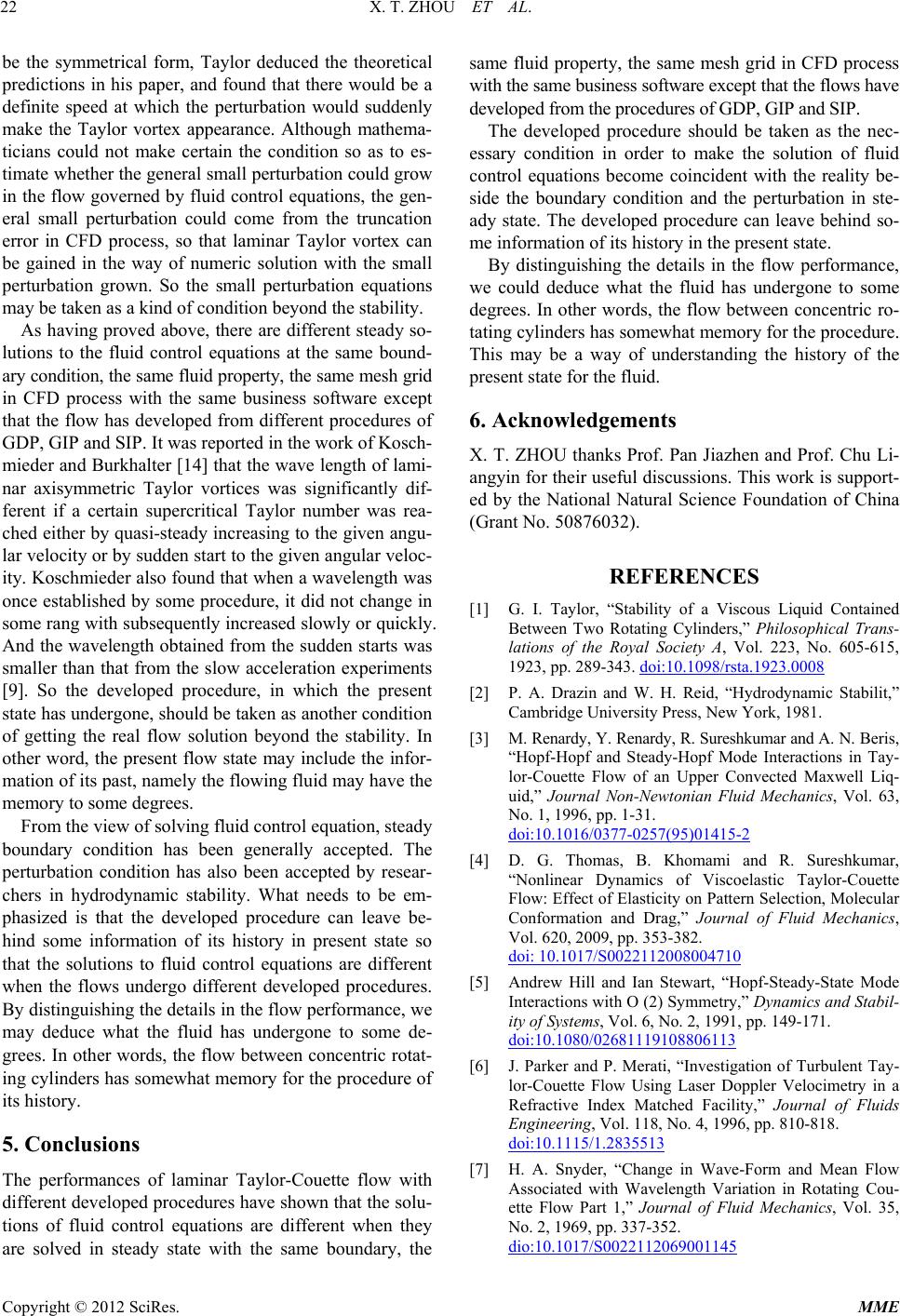
X. T. ZHOU ET AL.
22
be the symmetrical form, Taylor deduced the theoretical
predictions in his paper, and found that there would be a
definite speed at which the perturbation would suddenly
make the Taylor vortex appearance. Although mathema-
ticians could not make certain the condition so as to es-
timate whether the general small perturbation could grow
in the flow governed by fluid control equations, the gen-
eral small perturbation could come from the truncation
error in CFD process, so that laminar Taylor vortex can
be gained in the way of numeric solution with the small
perturbation grown. So the small perturbation equations
may be taken as a kind of condition beyond the stability.
As having proved above, there are different steady so-
lutions to the fluid control equations at the same bound-
ary condition, the same fluid property, the same mesh grid
in CFD process with the same business software except
that the flow has developed from different procedures of
GDP, GIP and SIP. It was reported in the work of Kosch-
mieder and Burkhalter [14] that the wave length of lami-
nar axisymmetric Taylor vortices was significantly dif-
ferent if a certain supercritical Taylor number was rea-
ched either by quasi-steady increasing to the given angu-
lar velocity or by sudden start to the given angular veloc-
ity. Koschmieder also found that when a wavelength was
once established by some procedure, it did not change in
some rang with subsequently increased slowly or quickly.
And the wavelength obtained from the sudden starts was
smaller than that from the slow acceleration experiments
[9]. So the developed procedure, in which the present
state has undergone, should be taken as another condition
of getting the real flow solution beyond the stability. In
other word, the present flow state may include the infor-
mation of its past, namely the flowing fluid may have the
memory to some degrees.
From the view of solving fluid control equation, steady
boundary condition has been generally accepted. The
perturbation condition has also been accepted by resear-
chers in hydrodynamic stability. What needs to be em-
phasized is that the developed procedure can leave be-
hind some information of its history in present state so
that the solutions to fluid control equations are different
when the flows undergo different developed procedures.
By distinguishing the details in the flow performance, we
may deduce what the fluid has undergone to some de-
grees. In other words, the flow between concentric rotat-
ing cylinders has somewhat memory for the procedure of
its history.
5. Conclusions
The performances of laminar Taylor-Couette flow with
different developed procedures have shown that the solu-
tions of fluid control equations are different when they
are solved in steady state with the same boundary, the
same fluid property, the same mesh grid in CFD process
with the same business software except that the flows have
developed from the procedures of GDP, GIP and SIP.
The developed procedure should be taken as the nec-
essary condition in order to make the solution of fluid
control equations become coincident with the reality be-
side the boundary condition and the perturbation in ste-
ady state. The developed procedure can leave behind so-
me information of its history in the present state.
By distinguishing the details in the flow performance,
we could deduce what the fluid has undergone to some
degrees. In other words, the flow between concentric ro-
tating cylinders has somewhat memory for the procedure.
This may be a way of understanding the history of the
present state for the fluid.
6. Acknowledgements
X. T. ZHOU thanks Prof. Pan Jiazhen and Prof. Chu Li-
angyin for their useful discussions. This work is support-
ed by the National Natural Science Foundation of China
(Grant No. 50876032).
REFERENCES
[1] G. I. Taylor, “Stability of a Viscous Liquid Contained
Between Two Rotating Cylinders,” Philosophical Trans-
lations of the Royal Society A, Vol. 223, No. 605-615,
1923, pp. 289-343. doi:10.1098/rsta.1923.0008
[2] P. A. Drazin and W. H. Reid, “Hydrodynamic Stabilit,”
Cambridge University Press, New York, 1981.
[3] M. Renardy, Y. Renardy, R. Sureshkumar and A. N. Beris,
“Hopf-Hopf and Steady-Hopf Mode Interactions in Tay-
lor-Couette Flow of an Upper Convected Maxwell Liq-
uid,” Journal Non-Newtonian Fluid Mechanics, Vol. 63,
No. 1, 1996, pp. 1-31.
doi:10.1016/0377-0257(95)01415-2
[4] D. G. Thomas, B. Khomami and R. Sureshkumar,
“Nonlinear Dynamics of Viscoelastic Taylor-Couette
Flow: Effect of Elasticity on Pattern Selection, Molecular
Conformation and Drag,” Journal of Fluid Mechanics,
Vol. 620, 2009, pp. 353-382.
doi: 10.1017/S0022112008004710
[5] Andrew Hill and Ian Stewart, “Hopf-Steady-State Mode
Interactions with O (2) Symmetry,” Dynamics and Stabil-
ity of Systems, Vol. 6, No. 2, 1991, pp. 149-171.
doi:10.1080/02681119108806113
[6] J. Parker and P. Merati, “Investigation of Turbulent Tay-
lor-Couette Flow Using Laser Doppler Velocimetry in a
Refractive Index Matched Facility,” Journal of Fluids
Engineering, Vol. 118, No. 4, 1996, pp. 810-818.
doi:10.1115/1.2835513
[7] H. A. Snyder, “Change in Wave-Form and Mean Flow
Associated with Wavelength Variation in Rotating Cou-
ette Flow Part 1,” Journal of Fluid Mechanics, Vol. 35,
No. 2, 1969, pp. 337-352.
dio:10.1017/S0022112069001145
Copyright © 2012 SciRes. MME